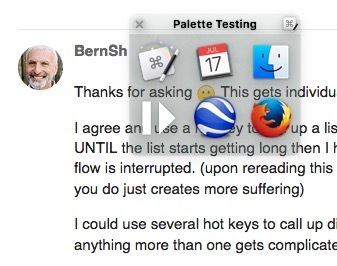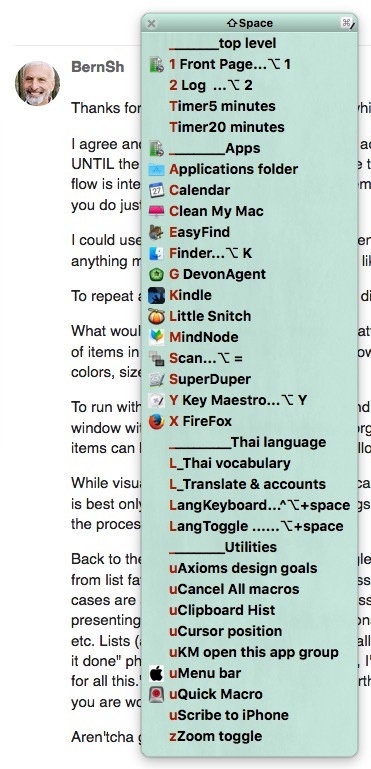Yes.
Palettes are among the most powerful features of KM.
So I am pleased to discuss more.
.
That's an important point.
Yes, I've felt the interruption -- but never thought about it consciously until you mentioned it.
In that regard, what do you think about typed string triggers?
I've found them useful to minimize interruption of flow.
Example -- enter current time:
ttt
.
[quote="BernSh, post:3, topic:5642"]
(upon rereading this it reminds more of the Buddhist notion of suffering, whatever you do just creates more suffering)[/quote]
(I am surrounded on all sides by 50 million Buddhists. I could go on at length about the suffering they impose on themselves. But then you, and others reading here, would suffer.)
.
I like that design goal.
Worth discussion.
How do you pursue "one and done" within KM?
I use "available" and "activated" functions in the macro group -- mainly based on window titles.
Have you found other/better ways to focus on "one and done"?
.
[quote="BernSh, post:3, topic:5642"]
... more formatting option for ... more rapid ID ... beyond five or so items. Options like spacers, bolding, colors, size, or dividers. [/quote]
How can we use palettes to the maximum within the current feature set?
I'll post two examples showing some of the formats you mentioned at the bottom of this post.
Not elegant, but they work.
I'd appreciate thoughts and ideas for more creative formatting.
.
[quote="BernSh, post:3, topic:5642"]
palette with the options like a finder window with icons that can be moved and organized in space [/quote]
Nice idea.
A previous thread on this forum mentioned graphics programs which have something like that built in. (Not macros, just their own internal functions).
And I've done some experimenting with palette formatting.
Within KM (as it is today) we can get do a lot, but not as easy as in the Finder.
Link at the bottom of this post.
.
I wish you'd start a topic here about that: "How to simplify (KM macro presentation)".
Would be a very useful topic.
.
Yes, indeed.
KM does offer palette style with icons/buttons only.
So it is possible to have just buttons appear -- no lists.
And several can appear at once = multiple buttons, in different positions.
If you've already tried that, what is your opinion?
.
Very interesting idea!
I may be the only other person here who is curious about that, but I am very curious.
If you consciously thought about "artful" presentation in KM, what would you do?
Your thoughts, please.
.
Here are two different styles of palettes -- offered for critique and discussion:

In palette below, a conflict palette, red characters trigger the macros. No need to mouse around and click.

.
Link to topic about other styles of palettes:
https://forum.keyboardmaestro.com/t/suggestion-pie-radial-menus/5518?u=mark